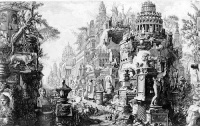Fictitious
From The Art and Popular Culture Encyclopedia
(Difference between revisions)
| Revision as of 16:26, 20 April 2008 Jahsonic (Talk | contribs) ← Previous diff |
Current revision Jahsonic (Talk | contribs) |
||
| Line 1: | Line 1: | ||
| - | [[Image:Antichità Romane.jpg|thumb|right|200px|The late [[Baroque]] works of [[Claude Lorrain]] and [[Salvatore Rosa]] had featured [[romantic]] and [[fantastic]] depictions of [[ruin]]s; in part as a [[memento mori]] or as a [[reminiscence]] of a [[golden age]] of [[architecture]]. [[Piranesi]]'s reproductions (see right) of real and [[fictitious]] [[Roman Empire|Roman]] ruins were a strong influence on [[Neoclassicism]]. ]] | + | [[Image:Ancient Rome (1757) by Giovanni Paolo Panini.jpg|thumb|left|200px|''[[Ancient Rome (painting)|Ancient Rome]]'' (1757) by [[Giovanni Paolo Panini]], a real painting depicting [[imaginary painting]]s of actual Roman antiquities.]] |
| + | {| class="toccolours" style="float: left; margin-left: 1em; margin-right: 2em; font-size: 85%; background:#c6dbf7; color:black; width:30em; max-width: 40%;" cellspacing="5" | ||
| + | | style="text-align: left;" | | ||
| + | "[A ''[[Romance]]'' is a] [[fictitious]] [[narrative]] in prose or verse; the interest of which turns upon [[marvellous]] and [[uncommon]] [[incident]]s; [...] being thus opposed to the kindred term ''[[Novel]]'', [which is] “a fictitious narrative, differing from the ''Romance'', because the events are accommodated to the ordinary train of human events, and the [[modern society|modern state of society]].”--"[[Essays on Chivalry, Romance, and the Drama|Essay on Romance]]" (c. 1815) by Walter Scott | ||
| + | |} | ||
| + | [[Image:Antichità Romane.jpg|thumb|right|200px| | ||
| + | [[Piranesi]]'s reproductions (see right) of real and [[fictitious]] [[Roman Empire|Roman]] ruins were a strong influence on [[Neoclassicism]]. ]] | ||
| {{Template}} | {{Template}} | ||
| - | '''For literary uses''' see ''[[fictional]]'' | + | |
| - | #:''[[Vernon Sullivan]] is a fictitious writer invented by [[Boris Vian]].'' | + | '''Fictitious''' or '''fictive''' means [[not real]]; [[invented]]; [[contrived]]. |
| + | For literary uses see ''[[fictional]]'', which has a neutral connotation, while both ''fictitious'' and ''fictive'' can have [[negative connotation]]s. | ||
| + | ==Usage== | ||
| + | # ''St. Mary Mead is a fictitious village from the books of [[Agatha Christie]].'' | ||
| + | # ''[[Vernon Sullivan]] is a [[fictitious writer]] invented by [[Boris Vian]].'' | ||
| ==Synonyms== | ==Synonyms== | ||
| - | *[[imaginary]], [[invented]] | + | * [[imaginary]], [[invented]], [[contrived]], fictive, [[fictional]], [[chimerical]] or [[fanciful]] |
| + | |||
| + | == See also == | ||
| + | *[[Fact and fiction]] | ||
| + | *[[Fancy portrait]] | ||
| + | *[[Figment]] | ||
| + | *[[Fingo]] | ||
| + | *[[List of fictitious people]] | ||
| + | *[[All persons fictitious disclaimer]] | ||
| {{GFDL}} | {{GFDL}} | ||
Current revision
_by_Giovanni_Paolo_Panini.jpg)
Ancient Rome (1757) by Giovanni Paolo Panini, a real painting depicting imaginary paintings of actual Roman antiquities.
|
"[A Romance is a] fictitious narrative in prose or verse; the interest of which turns upon marvellous and uncommon incidents; [...] being thus opposed to the kindred term Novel, [which is] “a fictitious narrative, differing from the Romance, because the events are accommodated to the ordinary train of human events, and the modern state of society.”--"Essay on Romance" (c. 1815) by Walter Scott |

Piranesi's reproductions (see right) of real and fictitious Roman ruins were a strong influence on Neoclassicism.
|
Related e |
|
Featured: |
Fictitious or fictive means not real; invented; contrived. For literary uses see fictional, which has a neutral connotation, while both fictitious and fictive can have negative connotations.
[edit]
Usage
- St. Mary Mead is a fictitious village from the books of Agatha Christie.
- Vernon Sullivan is a fictitious writer invented by Boris Vian.
[edit]
Synonyms
[edit]
See also
- Fact and fiction
- Fancy portrait
- Figment
- Fingo
- List of fictitious people
- All persons fictitious disclaimer
Unless indicated otherwise, the text in this article is either based on Wikipedia article "Fictitious" or another language Wikipedia page thereof used under the terms of the GNU Free Documentation License; or on research by Jahsonic and friends. See Art and Popular Culture's copyright notice.

